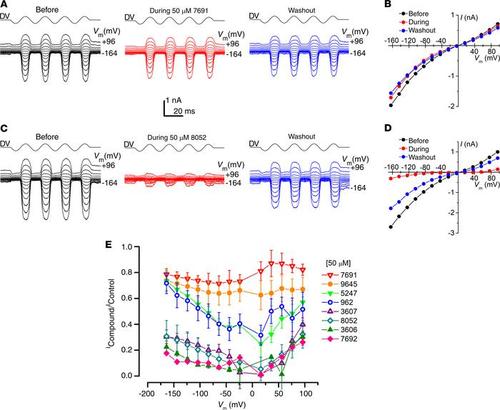Fig. 5
- ID
- ZDB-FIG-210504-5
- Publication
- Kenyon et al., 2021 - Identification of a novel series of hair-cell MET channel blockers that protect against aminoglycoside-induced ototoxicity
- Other Figures
- All Figure Page
- Back to All Figure Page
|
All 8 hit compounds block the MET channel to varying degrees. (A) MET currents recorded from an OHC before, during, and after extracellular exposure to 50 μM UoS-7691. Currents were recorded at membrane potentials ranging from –164 to +96 mV with channel opening and closing achieved by a sinusoidal stimulus delivered to the fluid jet (driver voltage, DV). (B) Current-voltage curves before, during, and after extracellular exposure to 50 μM UoS-7692 derived from currents shown in A. Cell capacitance was 8.2 pF. (C) MET currents from another OHC before, during, and after exposure to 50 μM UoS-8052. (D) Current-voltage curves derived from the currents shown in C. Cell capacitance was 7.0 pF. (E) Average fractional block curves (mean ± SEM) for all 8 compounds at 50 μM. Cell numbers: UoS-962 (n = 7); UoS-3606 (n = 4); UoS-3607 (n = 4); UoS-5247 (n = 4); UoS-7691 (n = 3); UoS-7692 (n = 3); UoS-8052 (n = 4); UoS-9645 (n = 9). |

